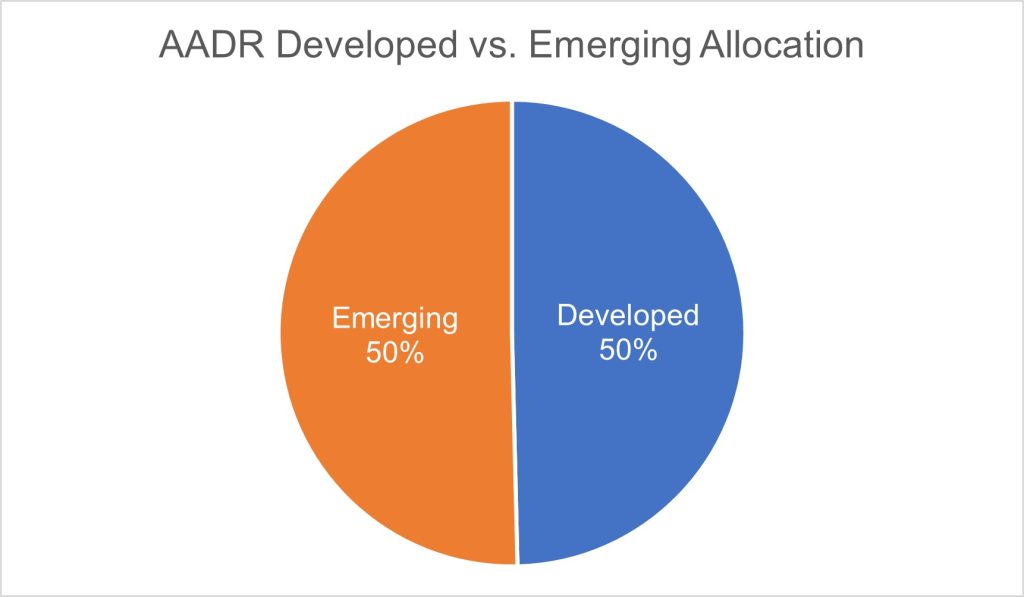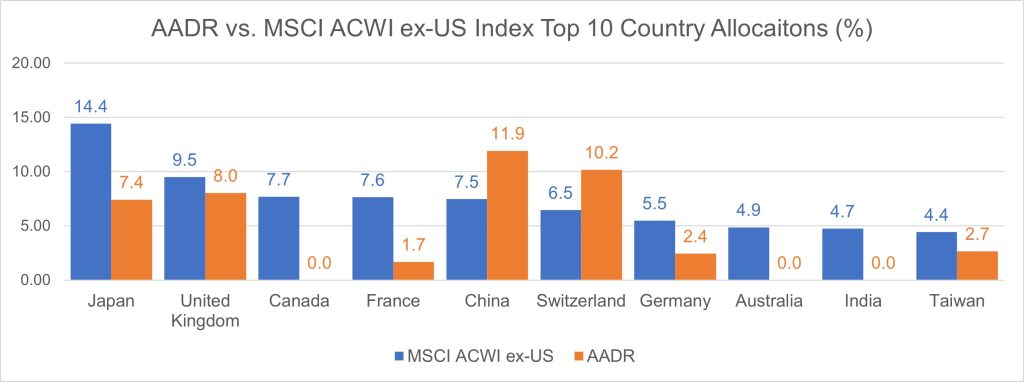AADR: 4th Quarter 2023 Portfolio Review
Strategy
The AdvisorShares Dorsey Wright ADR ETF’s (AADR) strategy uses relative strength to allocate towards the strongest performing ADR’s in the Developed and Emerging Markets. The strategy starts with a top down approach, first ranking each sector based on its relative strength scores and then setting the weighting of each sector. Holdings are scored daily based on an in-house momentum score which compares each security to the peers in the universe. If a securities rank fall below our sell threshold, it is removed. The strategy is not constrained to holding a set allocation to Emerging or Developed Markets, rather the process identifies areas of strength across the globe regardless of geographical location. This allows the portfolio to over or underweight regions and markets to concentrate on areas of strength, often pushing the portfolio to vary dramatically from international benchmarks.
Performance
AADR performed well in Q4 as it rose +14.98% (market) vs. +10.11% for the MSCI All World ex-US Index. The outperformance largely came from investments in Latin America (Argentina) and Western Europe (Switzerland) where we have meaningful overweights that worked in our favor. This helped AADR beat the benchmark for 2023 as it outperformed +18.58% (market) vs. +15.63% for the MSCI All World ex-US Index. New Oriental Education (EDU) was the standout stock this quarter as it added +1.24% of return.
Holdings
The portfolio continues to be allocated to securities that we believe display favorable relative strength characteristics. At any given time, the portfolio will be comprised of 30-40 US traded ADR’s from our universe of 300-450 ADR’s. Currently, the portfolio consists of 38 securities with weights ranging from ~1.05% to ~6.03%% with the top 10 holdings comprising roughly 38% of the portfolio.
Top 10 Holdings
| Ticker | Security Description | Portfolio Weight % |
| NVO | NOVO-NORDISK A/S-SPONS ADR | 6.03% |
| UBS | UBS GROUP AG-REG | 4.26% |
| YPF | YPF S.A.-SPONSORED ADR | 4.20% |
| EDU | NEW ORIENTAL EDUCATIO-SP ADR | 3.70% |
| ABBNY | ABB LTD-SPON ADR | 3.60% |
| PKX | POSCO HOLDINGS INC -SPON ADR | 3.43% |
| MUFG | MITSUBISHI UFJ FINL-SPON ADR | 3.36% |
| PAM | PAMPA ENERGIA SA-SPON ADR | 3.22% |
| RELX | RELX PLC – SPON ADR | 3.17% |
| BBVA | BANCO BILBAO VIZCAYA-SP ADR | 3.06% |
As of 12.31.2023.
Geography
The portfolio’s process of focusing on sectors and the strength of holdings allows the portfolio to look much different than the broad market benchmark. The current allocation though is much closer to the benchmark’s allocation when comparing Developed vs. Emerging Market Exposure. This is largely due to the positive relative performance of Developed Markets over the last year as mentioned before as the strategy seeks to rotate into strength. This has started to change though as the relative strength of Emerging Markets has begun to pick up a bit.
The portfolio’s process of focusing on sectors and the strength of holdings allows the portfolio to look much different than the broad market benchmark. The current allocation also looks different when comparing Developed Market vs. Emerging Market exposure. The portfolio currently holds an equal amount in Developed and Emerging while the benchmark holds roughly 67% in Developed. The country allocations are also substantially different. As can be seen below, AADR holds no exposure to Canada, Australia, and India and reduced exposure to Japan, UK, France, Germany, and Taiwan which are all large weights in the benchmark. Instead, we have excess allocations to countries like China and Switzerland where we’ve seen relative strength of late. At times we’ll own many countries which would never have large allocations in a passive benchmark (Argentina is a current example).


As of 12.31.2023.
Sector
The buy/sell process of the strategy starts with a look at the strongest sectors within the universe, overweighting strength and underweighting or eliminating relative weakness. The portfolio continues to be actively allocated to sectors in a materially different way than the benchmark. Notably, the portfolio is most overweight in Consumer Discretionary, Energy, and Utilities while most underweight in Financials, Communication Services, and Consumer Staples.

As of 12.31.2023.
![]() Respectfully,
Respectfully,
John G. Lewis
Nasdaq Dorsey Wright
AdvisorShares Dorsey Wright ADR ETF (AADR) Portfolio Manager
Past Manager Commentary
Definitions:
An American Depositary Receipt (ADR) is a negotiable U.S. Security that generally represents a company’s publicly traded equity or debt. Depositary Receipts are created when a broker purchases a non-U.S. company’s shares on its home stock market and delivers the shares to the depositary’s local custodian bank, and then instructs the depositary bank to issue Depositary Receipts.
The MSCI All Country World Ex-U.S. Index (ACWI) is a free float adjusted market capitalization weighted index that is designed to measure the equity market performance of developed and emerging markets.
Before investing you should carefully consider the Fund’s investment objectives, risks, charges and expenses. This and other information is in the prospectus, a copy of which may be obtained by visiting www.advisorshares.com. Please read the prospectus carefully before you invest. Foreside Fund Services, LLC, distributor.
There is no guarantee that the Fund will achieve its investment objective. An investment in the Fund is subject to risk, including the possible loss of principal amount invested. Emerging Markets, which consist of countries or markets with low to middle income economics can be subject to greater social, economic, regulatory and political uncertainties and can be extremely volatile. Other Fund risks include concentration risk, foreign securities and currency risk, ADRs which may be less liquid, large-cap risk, early closing risk, counterparty risk and trading risk, which can increase Fund expenses and may decrease Fund performance. The Fund is, also, subject to the same risks associated with the underlying ETFs, which can result in higher volatility. This Fund may not be suitable for all investors. See prospectus for detail regarding risk.
Shares are bought and sold at market price (closing price) not NAV and are not individually redeemed from the Fund. Market price returns are based on the midpoint of the bid/ask spread at 4:00 pm Eastern Time (when NAV is normally determined), and do not represent the return you would receive if you traded at other times.
Holdings and allocations are subject to risks and to change.
The views in this commentary are those of the portfolio manager and may not reflect his views on the date this material is distributed or anytime thereafter. These views are intended to assist shareholders in understanding their investments and do not constitute investment advice.
